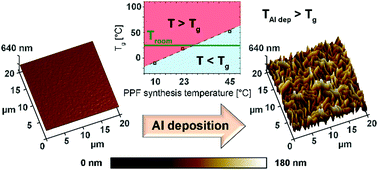Investigating the relationship between the mechanical properties of plasma polymer-like thin films and their glass transition temperature†
Abstract
This work aims at understanding the influence of the substrate temperature (Ts) on the viscoelastic properties of propanethiol plasma polymer films (PPFs). By means of state-of-the-art AFM characterization-based techniques including peak force quantitative nanomechanical mapping (PFQNM), nano dynamic mechanical analysis (nDMA) and “scratch” experiments, it has been demonstrated that the mechanical behaviour of PPFs is dramatically affected by the thermal conditions of the substrate. Indeed, the material behaves from a high viscous liquid (i.e. viscosity ∼ 106 Pa s) to a viscoelastic solid (loss modulus ∼ 1.17 GPa, storage modulus ∼ 1.61 GPa) and finally to an elastic solid (loss modulus ∼ 1.95 GPa, storage modulus ∼ 8.51 GPa) when increasing Ts from 10 to 45 °C. This behaviour is ascribed to an increase in the surface glass transition temperature of the polymeric network. The latter has been correlated with the chemical composition through the presence of unbound molecules acting as plasticizers and the cross-linking density of the layers. In a second step, this knowledge is exploited for the fabrication of a nanopattern by generating surface instabilities in the propanethiol PPF/Al bilayer system.



 Please wait while we load your content...
Please wait while we load your content...